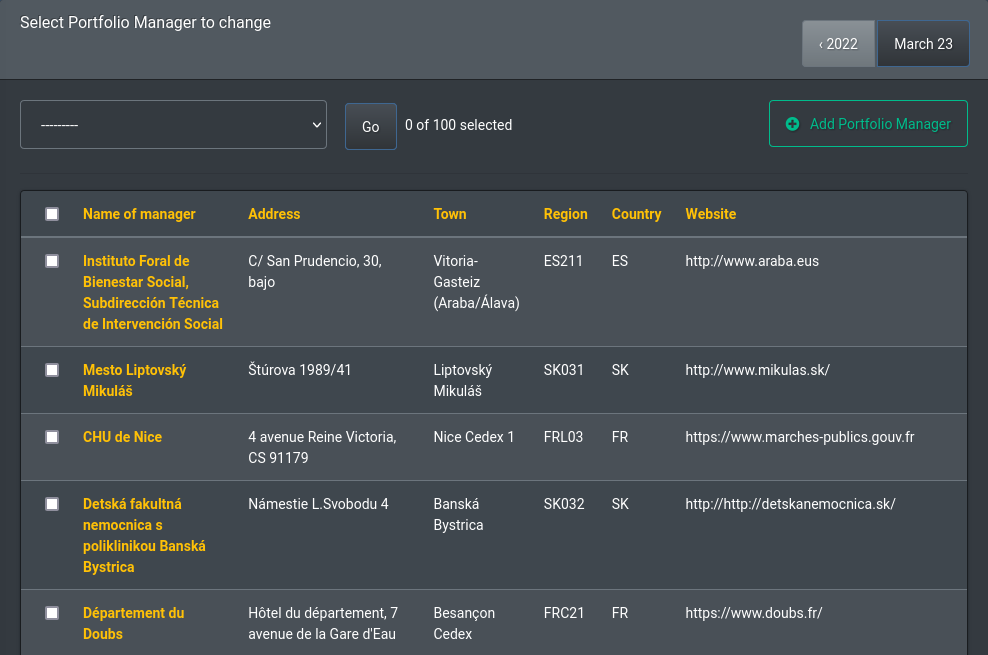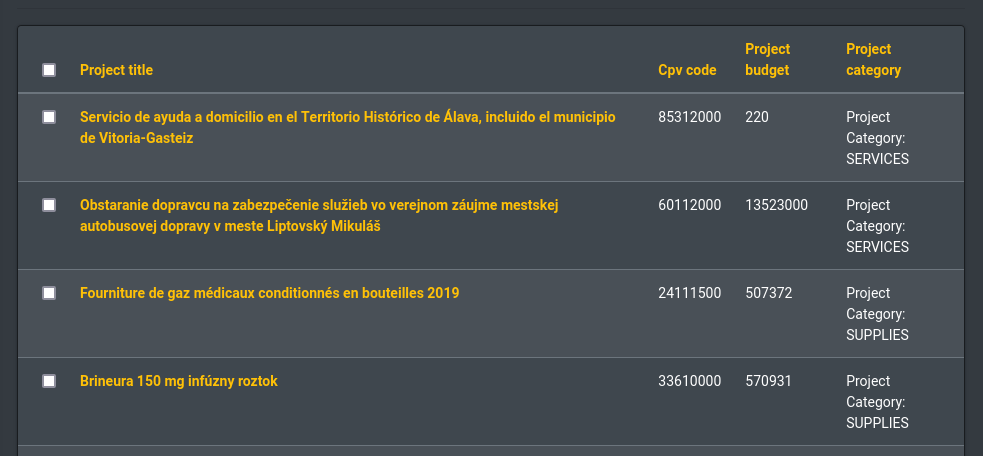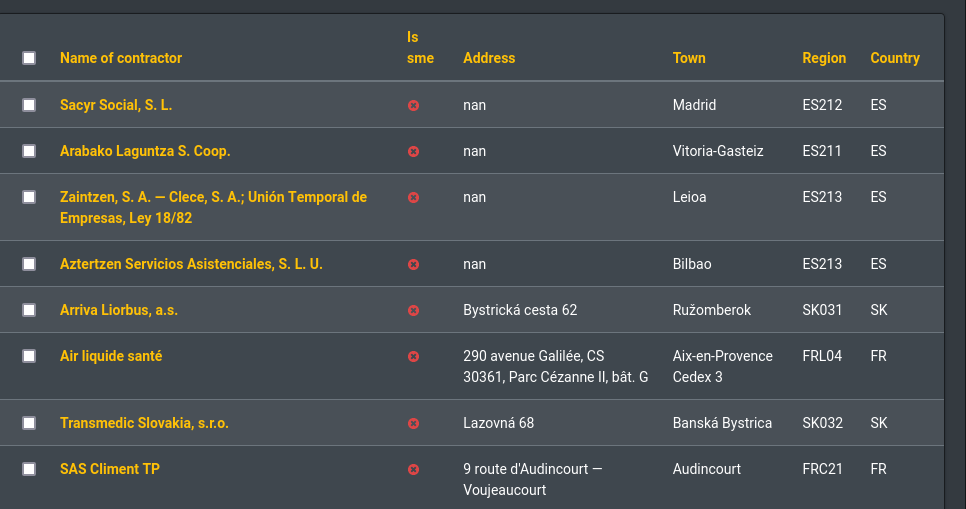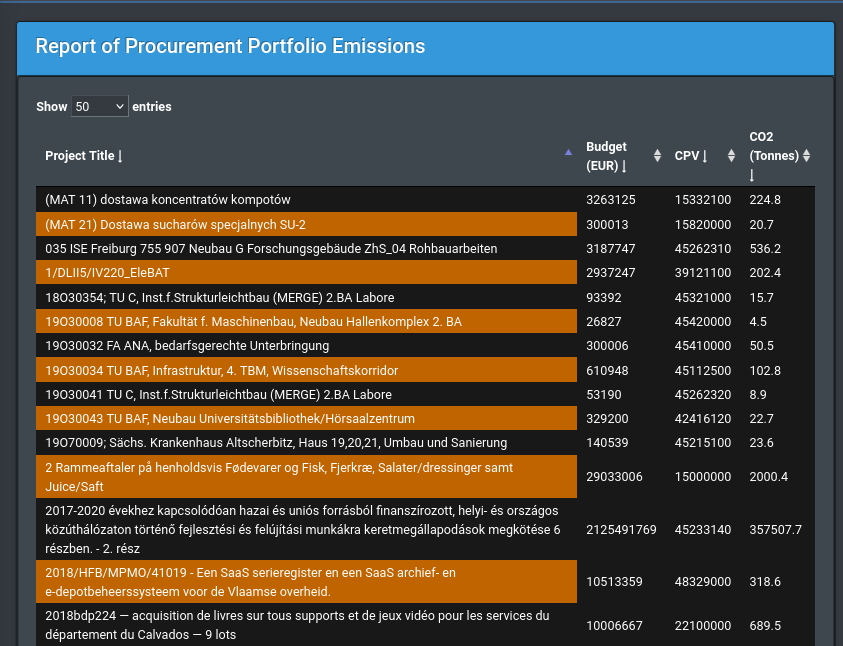Equinox Green Public Procurement Workflow
Europe’s public authorities are major consumers of goods and services via the public procurement process. By using their purchasing power to choose environmentally friendly goods, services and works, they can make an important contribution to sustainable consumption and production - what is called Green Public Procurement (GPP) or green purchasing. GPP is a voluntary instrument, not a legal standard, but has a key role to play in the EU’s efforts to become a more resource-efficient economy. To be effective, GPP requires the inclusion of clear and verifiable environmental criteria for products and services in the public procurement process. In Equinox we aim to support GPP by integrating the de-facto standard data models and ontologies of the TED platform into sustainable portfolio workflows.
Procurement Portfolios
The implementation of the methodology within Equinox follows the principles articulated in the White Paper Economic Networks as Property Graphs 1 which emphasizes the capture of dependencies between different economic actors and the stakeholders involved in economic exchange. In this use case this approach translates into the following data models:
- Buyers (the Purchasing Authorities) as special class of Portfolio Managers, the actors responsible for the monitoring and management of a procurement portfolio
- A Buyer Objective (the procurement of required supplies, works or services) is a Project which can, e.g., be mapped to the GHG Protocol.
- Procurement Contracts mapped as a special class of bilateral Contracts (distinct from Loans or other financial contracts).
- Contractors are a special class of Counterparty (this data model is shared also with the Project Finance workflow)
Portfolio Managers and Portfolios
All procurement contracts of an entity are grouped as part of a Procurement Portfolio linked to that purchasing entity. This aggregation allows the systematic analysis of both historical and current activities of all entities.

Procurement Project
All procurements pursued by a purchasing entity (when formalized as a TED notice) are modelled as a Project. Whether this concerns works or supplies of services, procurements always have a defined environmental and social impact. The current focus in Equinox is portfolio-wide management of GHG emissions profiles.
The type of project is captured via its CPV (Common Procurement Vocabulary).

NOTE: A Procurement Project need not be an awarded contract. In cases where the procurement procedure was successful, it will lead to one or more Procurement Contracts with one or more Contractors. Otherwise, it remains in the database simply as a historical data point.
Procurement Project Activities, Ex-ante and Ex-post Analysis
In the simplest case each Procurement Project corresponds to one Procurement Project Activity. When the procurement contract involves several components (Lots or other subdivisions) each one corresponds to a distinct Project Activity. In principle, each Activity can be (ex-ante) analysed following the GHG Protocol principles, including its Primary and Secondary Effects.
For historical (ex-post) analysis, the mapping of procurement activities to sectoral environmental profiles leads to a historical and statistical analysis of how public procurement contributes to sustainability.
Contractors
For existing procurements the collection of actual Contractors allows a diverse range of portfolio management activities, including the computation of various indicators of diversity / concentration risk (See Connecting the Dots: Concentration, diversity, inequality and sparsity in economic networks 2)

Procurement Emissions Reports
Utilizing the CPV code of a contract and a mapping of products and services to NACE sectors one can leverage EEIO databases and attribute GHG emissions to select components of the procurement portfolio (subject to a number of data and a number of conceptual uncertainties!)

Further Reading and References
How Open Data and Open Source can support Green Public Procurement
In a series of blog posts we dig deeper into the details of the Green Public Procurement workflow
- EU Datathon 2022
- Part 1 we motivate and define the scope of a study that explores Public Procurement data
- Part 2 we dig deeper to construct an economic representation of the public procurement process
- Part 3 we link procurement entities to private sector sellers and through the sectoral profile of the procurement contract (CPV category) we infer the amount of CO2 emissions that can be attributed to these activities
- Part 4 we discuss how the procurement oriented data framework we have developed within the Equinox platform can be mapped into classic portfolio management concepts and categories
- Input-Output Models with Python
Sustainable Portfolio Management with Equinox
- Sustainable Portfolio Management
- Equinox 0.4 Release
- The GHG Scope 2 Workflow focuses on Scope 2 (purchased electricity) accounting and reporting.
- The CIRIS Workflow for compiling a City-wide emissions report
- The PCAF Mortgages Workflow for compling the emissions profile of a portfolio of mortgages (loans secured against real estate with measurable GHG emissions).
- The PCAF Project Finance Workflow
- The GHG Project Workflow that focuses on individual Project impact analysis (thus this is an example that does not need involve a portfolio).
- The Emission Factor Database Workflow illustrates working with reference data (in this case the IPCC emissions factor database)
- The EBA Scorecard for Project Finance implements a standardized credit scorecard for Project Finance
- List of standards, white papers and other resources